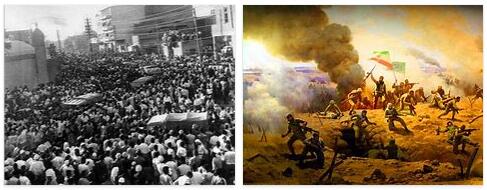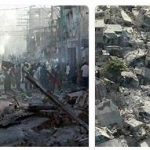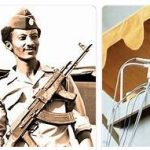Iraq History: The Way to Regain Sovereignty
The transitional government defined the preparation of direct elections to a constituent assembly by early 2005 as its primary goal. On June 8, 2004, the UN Security Council passed a new Iraq resolution, which provided for the establishment of a special national committee for future coordination between the leadership of the coalition forces and the transitional government. In view of the situation in the Shiite and Sunni resistance centers (especially in the “Sunni triangle” between Tikrit, Baghdad and Ramadi) and the ongoing threat from the activities of foreign terrorists, the American government decided to maintain a troop strength of 138,000 soldiers in Iraq; moreover, the US was increasingly searching, both UN and NATO to be more involved in the stabilization of the country. In the run-up to the official handover of power on June 28, 2004 (dissolution of the civil interim administration of the military alliance [CPA] under Bremer) to the Iraqi government, there were a series of bloody attacks with over 100 deaths. On June 30, 2004, Saddam became Husain transferred to Iraqi justice; Proceedings were initiated against the dictator and other leading representatives of his overthrown regime before the special tribunal; at the same time, the interim government decided to reintroduce the death penalty. In mid-August 2004 a national conference met in Baghdad, the approximately 1,000 members of which elected an interim parliament, the Iraqi National Council, to represent all parts of the country and population.
With the mediation of Grand Ayatollah SA al-Sistani , one of the leading religious authorities of the Iraqi Shiites, at the end of August 2004 the Mahdi militias could be induced to a ceasefire and to leave the – most recently fiercely contested – holy sites of Nedjef after their leader al- Sadr had been assured of impunity. A military offensive by American troops was directed against the rebel stronghold of Falluja in November 2004 (around 1,200 insurgents were killed); the Jordanian Abu Musab al-Zarqawi (* 1966) responsible for numerous bloody hostages and attacks, Leader of a terrorist group that joined al-Qaeda in 2004, could not be caught. In December 2004, the American inspectors stopped their hitherto unsuccessful search for Iraqi weapons of mass destruction. Regardless of the continuing precarious security situation in the country, to which the USA reacted by announcing an increase in troop strength to 150,000 soldiers, the Allawi interim government scheduled elections for January 30, 2005. The elections for a constituent provisional national assembly and regional elections took place on the planned date under the strictest security precautions. Despite terror threats in advance and numerous attacks on election day as well as an extensive election boycott by the Sunni population, participation in the first free Iraqi ballot since 1953, 7,200 candidates (representatives of 75 parties and nine electoral alliances as well as 27 individual candidates) stood for election to the National Assembly, around 60%. The election winner was that of Grand Ayatollah Sistani supported the Shiite electoral alliance United Iraqi Alliance (140 of the 275 seats), followed by the joint Kurdish list (75 seats) and the electoral alliance led by the interim premier Allawi (40 seats). After weeks of political struggle to fill important state and government offices, parliament elected the Kurdish politician Talabani (PUK) as President of Iraq on April 6, 2005 ; Almost three months after the January elections, on April 28, 2005, the National Assembly also confirmed the government led by the Shiite politician Ibrahim al Jaafari (* 1947).
Overshadowed by a sustained escalation of violence, the National Assembly drafted a new constitution, which was approved in a referendum on October 15, 2005 with more than 78% of the votes; the constitution was largely rejected by the Sunni part of the population.
This time the Sunni population also took part in the parliamentary elections on December 15, 2005. The Shiite United Iraqi Alliance was again the strongest party, but failed to gain an absolute majority. Their coalition partner, the Kurdish list, also lost votes, while Sunni parties gained significantly.
The already difficult formation of a government was overshadowed by a bomb attack on the “Golden Tomb Mosque” in Samarra (serious damage to the important Shiite shrine) on February 22nd, 2006, as well as by subsequent reprisals (murder of numerous Sunni civilians and destruction of Sunni mosques). In May 2006, a government of “national unity” (participation of representatives of most parliamentary groups), formed as the new prime minister under Nuri al-Maliki (Shiite al-Dawa party), was finally confirmed by parliament.
On June 7, 2006, the US managed to kill Abu Musab al-Zarqawi , the leader of al-Qaeda in Iraq, by means of a targeted air strike near Baquba. His successor Abu Ayyub al-Masri (* 1967, † 2010) , also known as Abu Hamsa al-Muhadjir , continued the terrorist operations. After merging with other Sunni groups, the terrorist militia al-Qaeda in Iraq operated under the name Islamic State in Iraq (ISI) from autumn 2006. – In a first trial (2005/06) Saddam Husain was sentenced to death for massacring Shiites in 1982; the execution took place on December 30, 2006.
In January 2007, US President George W. Bush reacted to the increasing criticism of his Iraq policy with a stronger American military presence. By October 2007, the troop strength had increased from 130,000 to more than 170,000 soldiers. Under the new Commander-in-Chief, General David H. Petraeus , a security offensive should make it possible to hand over further provinces to the Iraqi government. On October 28, 2007 the province of Karbala was placed under Iraqi administration, on December 15. In 2007 the British troops surrendered the province of Basra. In the Shiite camp, the rivalry between the Mahdi militia of the preacher Muktada al-Sadr intensifiedand the Badr Brigades of the High Council for the Islamic Revolution in Iraq. Both groups are fighting for supremacy in the oil-rich south of the country. Attacks and suicide bombings as well as kidnappings were marked in 2007 by the power struggles within Iraq. On April 18, 2007, more than 170 people died in five attacks in Shiite neighborhoods in the capital, Baghdad. On February 2, 2007, 130 people were killed there by a car bomb explosion in a Shiite market. In April 2007, the six ministers of the Sadr Movement left the Maliki government because their demand for a withdrawal plan for American troops had not been met. On August 14, 2007, two of Yazidis were attacked hundreds of people died in inhabited villages. These were the worst attacks since the end of Saddam Husain’s regime.
In 2008 the number of terrorist attacks fell, but political normalization made little headway, and important questions about the distribution of political and economic power between the center and the periphery remained pending. According to the UN High Commissioner for Refugees from April 2008, Iraq was the scene of the largest refugee disaster in the Middle East since 1948, with 2.7 million displaced persons within the country and 5 million refugees abroad. The Shiite-Kurdish government coalition demonstrated its ability to act in January and February In 2008, with the adoption of the 2008 budget, an amnesty law for around 26,000 prisoners, and a law allowing former members of the Ba’ath Party to be re-employed in the civil service. The Iraqi security forces were able to take over the provinces of Anbar (west), Babylon and Wasit (center) from the occupation forces in September and October 2008, thus controlling a total of 13 provinces. However, kidnappings, assaults, and bombings and suicide attacks continued. In the spring of 2008, Iraqi government troops, with British and American support, undertook major offensives v. a. against the Mahdi army of the Shiite leader al-Sadr. Although the government troops prevailed in the strongholds of Sadr City (Baghdad) and Amara in May and September 2008, the Mahdi army remained a force of power. In November 2008, the Iraqi parliament approved a security agreement with the US that stipulated the withdrawal of American troops by the end of 2011.
In January 2009 local elections could take place in 14 out of 18 provinces. According to the 2008 security agreement, the US handed over its bases in cities and villages, with the exception of Mosul, to the Iraqi army and police by June 30, 2009. Despite some successes in improving the security situation, z. Sometimes devastating bomb attacks and suicide attacks. The Iraqi government put the death toll from politically motivated violence 2004-08 on the basis of issued death certificates at 85,695.
According to Programingplease, the parliamentary elections on March 7, 2010 were won by the opposition alliance Iraqi National Movement (Iraqija) led by I. Allawi with a narrow majority (91 seats) ahead of Maliki’s rule of law alliance (89 seats). The formation of a government proved extremely difficult. Finally, under Kurdish mediation, Allawi and Maliki agreed on a power-sharing that provided for Maliki the office of head of government and for Allawi the office of chairman of a new council for political strategy. In November 2010 the parliament re-elected J. Talabani as president. By MalikiThe new government formed comprised all important political forces and was ratified by parliament on December 21, 2010. On August 19, 2010, the US withdrew its last combat troops as agreed. Fewer than 50,000 foreign soldiers remained in the country. a. to advise and train the Iraqi security forces. American and Iraqi security forces continued to crack down on terrorists in 2010.
In 2011, the newly formed cabinet, led by Maliki , was mostly divided and barely able to act. Protests broke out in early February 2011 as part of the Arab Spring, primarily against inadequate basic services, unemployment and corruption. Prime Minister Maliki promised to take the demands seriously. At the same time, however, the police shot at the protesters. In the autonomous Kurdish part of the country, too, the state authorities reacted harshly to demonstrations. After the suppression of the predominantly Shiite protests in Bahrain in March 2011, Muktada called al-SadrThousands of Iraqi Shiites take to the streets for demonstrations. The last American soldiers left the country on December 18, 2011. At the same time, NATO stopped its training program for the Iraqi security forces. The last British troops had already left the country in May 2011. In 2011, too, the country was shaken by numerous terrorist attacks. In addition, the tensions between Shiites and Sunnis made political stabilization more difficult. On December 16, 2011, Prime Minister Maliki dismissed his Sunni deputy Saleh al-Mutlaq (* 1947) after he had been called a dictator. Vice President Tarik al-Hashemi(* 1942), the highest-ranking Sunni politician in the country, fled to the Kurdish north (then to Turkey) after Maliki had accused him of involvement in murder and terrorist attacks and obtained an arrest warrant against him. He was later sentenced to death in absentia.













